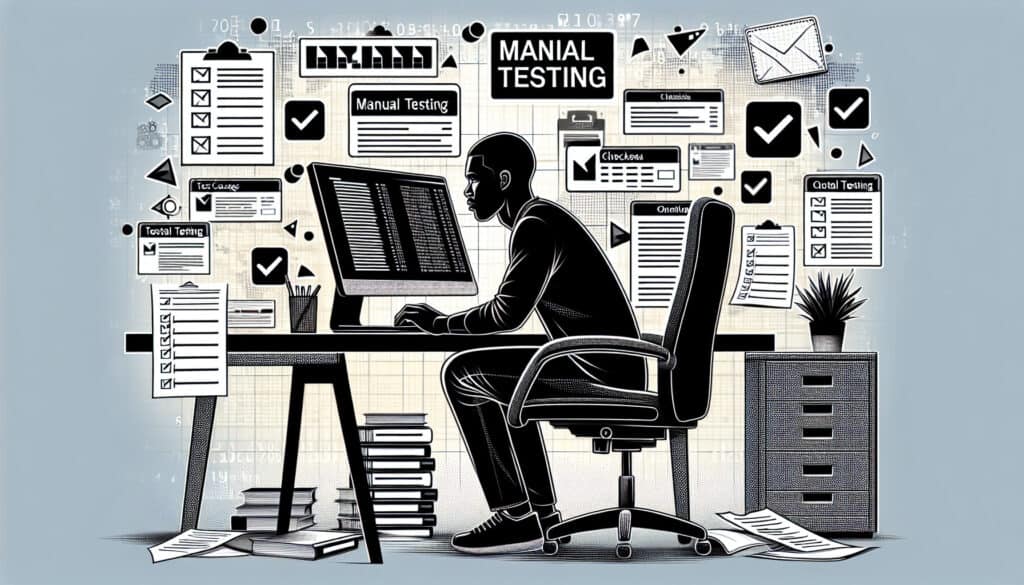To test Software by manually executing test cases without using any automation tools.
- Methodologien: Kunden & Marketing, Wirtschaft, Personalwesen, Projektmanagement
Manuelle Prüfung

Manuelle Prüfung
- Agile Methodik, Kontinuierliche Verbesserung, Qualitätssicherung, Qualitätsmanagement, Software-Prüfung, Prüfung der Benutzerfreundlichkeit, Benutzererfahrung (UX), Benutzeroberfläche (UI), Benutzer-Tests
Zielsetzung:
Wie es verwendet wird:
- A type of software testing where testers manually execute test cases. They follow a written test plan that leads them through a set of steps to test the functionality and usability of the software.
Vorteile
- Allows for human observation and intuition, which can find bugs that automation might miss; Flexible and can be used for exploratory testing.
Nachteile
- Can be time-consuming and prone to human error; Not suitable for repetitive or large-scale testing.
Kategorien:
- Qualität
Am besten geeignet für:
- Performing usability testing, exploratory testing, and ad-hoc testing on new software features.
Manual testing finds extensive applications across diverse industries, particularly in software development, gaming, healthcare, and financial services. This methodology is particularly applicable during the quality assurance phase of projects, where the goal is to validate new software features before they are released to end users. Testers, usually quality assurance engineers or dedicated testers, initiate this process by developing a detailed test plan that outlines the objectives, test cases, and expected results. Participants can include designers and developers who provide context on the functionality, ensuring a collaborative approach to identifying potential usability issues. Common applications include usability testing, where real users interact with the software to provide feedback on their experience; exploratory testing, which allows testers to creatively navigate the software to uncover unexpected behavior; and ad-hoc testing, which involves informal yet insightful examination of the software without a strict plan. The flexibility of manual testing permits testers to leverage their intuitive understanding of user behavior and preferences, often uncovering bugs that automated tests might overlook. This human-centered approach is crucial in applications that require high usability and user engagement, making it an effective choice during the early phases of software development or when rapid feedback is necessary, such as in Agile environments where quick iterations and adjustments are required.
Die wichtigsten Schritte dieser Methodik
- Review the test plan and understand the objectives of the test.
- Identify the key functionalities and features to be tested.
- Execute test cases sequentially, following prescribed steps.
- Document any deviations from expected results during testing.
- Perform exploratory testing based on observations and instincts.
- Engage in ad-hoc testing to uncover additional issues.
- Assess the usability of the software based on user experience.
- Collaborate with team members for immediate feedback on findings.
- Refine test cases based on findings for subsequent iterations.
Profi-Tipps
- Aktivieren Sie diverse user Menschen during testing sessions to capture a wide range of usability perspectives and behaviors.
- Document unexpected findings thoroughly to provide context for defects that may not follow a predetermined test plan.
- Incorporate feedback loops with development teams to ensure findings influence iterative design and feature enhancements effectively.
Verschiedene Methoden lesen und vergleichen, Wir empfehlen die
> Umfassendes Methoden-Repository <
zusammen mit den über 400 anderen Methoden.
Ihre Kommentare zu dieser Methodik oder zusätzliche Informationen sind willkommen auf der Kommentarbereich unten ↓ , sowie alle ingenieursbezogenen Ideen oder Links.
Historischer Kontext
1828
1850
1854
1854
1911
1928
1950
1827
1848
1850
1854
1895
1914
1943
1950
(wenn das Datum nicht bekannt oder nicht relevant ist, z. B. "Strömungsmechanik", wird eine gerundete Schätzung des bemerkenswerten Erscheinens angegeben)















Verwandte Artikel
METS-Kalorien-Rechner
Meta-Analyse
Nachrichten-Mapping
Mentalmodell-Diagramme
Maximal zulässige Druck- und Zugkräfte
Materialbedarfsplanung (MRP)